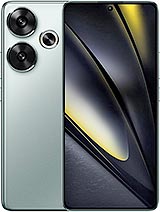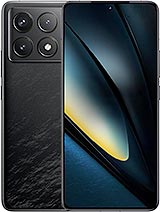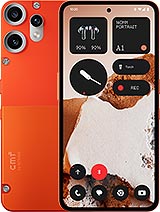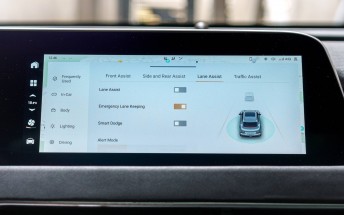Poco F6 vs. Poco F6 Pro

Poco undoubtedly has a great value proposition going with its latest F6 series. The vanilla F6 starts at $379 globally for a base 8GB/256GB unit, whereas the Poco F6 Pro has a $499 base MSRP for the 12GB/256GB model. That's not an insignificant price difference, and it leads us nicely to the main question we aim to answer - which one is a better deal and, ultimately, a better fit for you personally.
Despite sharing the same model family under the Poco brand, the two devices are quite different. Poco relies on Xiaomi RnD and tends to rebrand already existing Xiaomi models for its lineup. In this particular case, the vanilla F6 is based on the Xiaomi Redmi Turbo 3, whereas the F6 Pro is based on the Xiaomi Redmi K70. This approach to product development on Poco's end isn't intrinsically bad, but it does lead to some interesting disparities, like the fact that despite its "Pro" moniker, the F6 Pro lacks the proper ingress protection of its vanilla sibling as well as the Gorilla Glass Victus front.
So how much better is the Xiaomi Poco F6 Pro to deserve its price premium? Let's look into it.
Table of Contents:
For starters, you can compare the complete specs sheets or directly continue with our editor's assessment in the following text.
Size comparison
The two phones are very similar in overall dimensions, which is quite natural given that both have the same display diagonal at 6.67 inches and the same battery capacity at 5,000 mAh. They differ slightly in weight, with the vanilla Poco F6 coming in at 179 grams while the F6 Pro tips the scale at 209 grams. This is probably due to the difference in materials more than anything else.
The regular Poco F6 has a plastic back and a plastic frame, whereas the F6 Pro has a glass back and an aluminum frame. However, as we already mentioned in the intro, this doesn't tell the full story. Despite its more modest bill of materials, the vanilla F6 offers better overall protection. It has IP64 certification, while the F6 Pro is stuck with basic IP54. Also, the front of the vanilla F6 is covered with Gorilla Glass Victus, while the Pro model has a more basic Gorilla Glass 5 finish.
Let's talk about color options. The vanilla F6 kind of wins in this department since it comes in Green in addition to the more basic Black and Titanium. The F6 Pro can be had in either Black or White. Then again, we personally find the slight marble-like effect on the back of the F6 Pro more intriguing than the basic finish on the vanilla. So, let's call it a toss-up.
Speaking of design, while the two phones are very similar from the front, with their flat displays only interrupted by a punch-hole selfie and pretty thin bezels all around, we wouldn't call their backs similar at all. Beyond the signature pattern on the Pro we already mentioned, there is also a major difference in the camera islands. The vanilla F6 doesn't actually have one with two big circular individual cameras and an LED flash to the side. On the other hand, the Pro has a massive camera island stretching almost the entire width of the phone and much smaller circles for the cameras themselves. It's almost as if the two phones weren't meant to be related to begin with (wink, wink).
Regarding other interesting titbits, both phones have an IR blaster. Also, NFC in most markets. Both models also have a stereo speaker setup, with the earpiece acting as the second channel.
On the bottom, we have the SIM slot, which lacks expandable storage on either device, as well as the main speaker and the Type-C port. Both phones support USB Host/OTG but nothing else fancy like video output. So, you are stuck with USB 2.0 data speeds of 480 Mbps max on both phones.
It is also interesting to note that the Poco F6 Pro has a hardware proximity sensor, while the regular Poco F6 is stuck with a virtual proximity.
Display comparison
Both phones have the same large display diagonal of 6.67 inches. The similarities don't end there either, with 12-bit color, HDR10+, Dolby Vision certification and a 120Hz refresh rate. Those are some pretty great specs all around.
However, the F6 Pro still has a leg up in this department. First of all, it has a higher resolution of 1440 x 3200 pixels, compared to 1220 x 2712 pixels on the vanilla model. This naturally means that there is a difference in sharpness between the two phones. Mind you, it is not one that you can truly appreciate with the naked eye. At around 446 ppi, the Poco F6 still looks plenty sharp. However, the F6 Pro has a notably higher pixel density of around 526 ppi.
It is also worth noting that Poco advertises a much higher peak brightness of 4,000 nits for the Poco F6 Pro compared to 2,400 nits on the Poco F6. However, it is also worth pointing out that in our more practical standardized testing, both phones managed a very similar maximum brightness output of just over 1,200 nits. More than plenty to be comfortable outdoors.
Battery life
Both phones have 5,000 mAh battery packs on board and expectedly manage very similar, almost identical Active Use Scores in our testing. Neither phone does particularly well in the battery department compared to its peers. This has been an ongoing trend with recent Xiaomi devices, so we can't say that we are too surprised.
Charging speed
Xiaomi didn't skimp out on the charging solutions for the two phones. The Poco F6 Pro has a clear advantage here with its 120W charging solution. In our testing, it brought the F6 Pro from dead to full in just 27 minutes. Still, the vanilla Poco F6 is pretty close with its 90W charging and 37 minutes for a full charge.
In either case, you get the charger and a compatible cable in the retail box, which is great.
Speaker test
Both phones rely on a hybrid stereo speaker setup. There's one bottom-facing speaker and one that also acts as an earpiece. Both phones managed a Very Good loudness score in our standardized testing. The F6 Pro does have a small edge in loudness, but it is not significant enough to matter.
The audio quality is great on both phones. Mids are very clean throughout all volume ranges. Highs barely get distorted, and there is even some bass.
Performance
Both the Poco F6 and F6 Pro use what Qualcomm describes as premium chipsets. The vanilla Poco F6 is based on the Snapdragon 8s Gen 3 – a pretty new chip that is based on the regular Snapdragon 8 Gen 3 but with a few cutbacks.
The Poco F6 comes in an 8GB/256GB base variant and is also available in a higher-tier 12GB/512GB model. In both cases, you get speedy UFS 4.0 storage, but there is no expandable storage. Qualcomm also lowered the cost by using an older modem, but it still offers a high-end ISP as well as next-generation connectivity, such as Wi-Fi 7.
Speaking of older parts and lowering the cost, the Poco F6 Pro is based on last year's flagship Snapdragon 8 Gen 2 chipset. As you can imagine, it still packs quite the punch and has come down in price a bit at this point.
The chipset is paired with LPDDR5X RAM and fast UFS 4.0 storage. You can get the phone in three configurations - 12GB/256GB base, 12GB/512GB and a top tier 16GB/1TB model. There is no expandable storage here. You get modern connectivity features here as well, like tri-band Wi-Fi 7.
Both the Poco F6 Pro and F6 come with the promise of three years of major software updates and an additional year of security patches. And of course, they run the same software - the latest installment of HyperOS based on Android 14.
Benchmark performance
Naturally, the Poco F6 Pro, with its "full-fat" Snapdragon 8 Gen 2 chipset, is going to have a leg up in raw performance. However, looking at the actual benchmark numbers, the difference really isn't all that major.
In practice, the regular Poco F6 is already plenty powerful and easily chews through any task, including heavy gaming.
Camera comparison
The camera setups on the two Poco F6 models do look similar at first glance. Well, besides the fact that the F6 Pro has an extra camera on the back. A pretty insignificant 2MP dedicated macro one, though. Dig a little deeper, however, and you quickly start to see more differences.
For instance, while both phones use a 50MP main camera, the sensors are quite different. The vanilla Poco F6 moved from a 64MP OmniVision in its Poco F5 predecessor to a 50MP Sony IMX 882 (LYT600) without really upping the size of the sensor too much (1/1.95", 0.8µm - 1.6µm).
The F6 Pro also swaps the 64MP main unit of the F5 Pro for a 50MP OmniVision OVX8000 one, but before you dismiss it as a downgrade, bear in mind that the new sensor is a larger one - 1/1.55" (1.0µm - 2.0µm) instead of 1/2.0". The new lens is also brighter (f/1.6 vs. f/1.8), making the F6 Pro sound a lot more promising for low-light endeavors.
The Poco F6 and F6 Pro do share an ultrawide camera setup. Both phones use an 8MP Sony IMX 355 (1/4.0", 1.12µm) sensor. The 2MP macro unit is exclusive to the Pro, though, for what it's worth (not a whole lot).
As for selfies, the Poco F6 Pro also takes a different path from the plain F6, and it has a 16MP front-facing camera instead of the 20MP one on the F6. They also differ in their coverage, with the Pro having a more conventionally wide 24mm equivalent lens, while the vanilla model uses a wider 21mm lens.
Image quality
The Poco F6 Pro captures quite great daylight photos with its primary camera. Detail is excellent - random textures are rendered relatively naturally, and there's minimal grain in the skies.
The Poco F6's main camera does relatively well, too. The detail is very good, if not quite as organic as on the F6 Pro, while the noise is low, although there's still some fine grain here or there. The color rendition is quite likable - it's a notch below the Pro's slightly excessive pop. Dynamic range is great, too.






Main camera samples: Poco F6 Pro vs. Poco F6
The Poco F6 Pro does an excellent job of capturing people and faces.
The way the Poco F6 renders skin tones and faces, in general, isn't our favorite - some skin smoothing and whitening still remains despite us having disabled all the beautification features. It's not bad or anything, just not as good as it could be.






Main camera samples: Poco F6 Pro vs Poco F6
While both phones use the same ultrawide camera, at least as best we can tell, we did notice that the F6 Pro produced slightly nicer photos. Maybe the two different Snapdragons have their own specifics. Generally speaking, the ultrawide camera does alright, without shining in any particular manner, though we frankly expected worse from its unremarkable hardware.
Detail is alright, given the resolution, and whatever noise there is doesn't get in the way. On the vanilla model, in particular, colors can be a little muted, and there's a general aura of lifelessness, which we didn't experience on the Pro. To be fair, we'd have probably been just fine with the F6's shots, but it's just that the F6 Pro's are a little bit better.






Ultrawide camera samples: Poco F6 Pro vs. Poco F6
The Poco F6's main camera doesn't fear darkness and continues to deliver solid images at night. You don't need to worry much about going into night mode as the phone does well enough in full auto mode. Tonal development is very good; you'll typically get reasonably bright shadows and well-contained highlights. Detail and noise performance are good, and we have no major complaints about color either.
At 2x zoom, you can expect usable images, though looking at them at 1:1 will reveal their upscaled nature. The ultrawide camera's low-light photos are pretty meh. Dynamic range is alright, but colors are a little off. The images are also quite soft - more so than on the F6 Pro.






Low-light samples at 0.6x • 1x • 2x: Poco F6 Pro vs. Poco F6
The Poco F6 Pro captures very good photos with its main camera in low light. There is well-balanced exposure with good highlight preservation and shadow development.
The 2x zoom level remains usable at night, so long as you don't expect miracles when pixel-peeping. The ultrawide camera's photos are along the same vein. They look relatively good from afar in terms of exposure and dynamic range, though colors can be a bit overly warm and saturated.
Video quality
The Poco F6 and F6 Pro both have very similar video capture capabilities. Well, with the exception of 8K@24fps, which is only available on the Pro model. 8K on mobile is still kind of janky in most ways and not that different in quality from 4K, so we won't emphasize it much. The vanilla F6 also lacks the 4K@24fps cinematic option, which we can see being missed by some. Both phones have always-on stabilization and the option to choose between AVC/h.264 and HEVC/h.265.
4K clips from the main cameras of both phones are solid. The Poco F6 has very good detail at 30fps, which is on par with the F6 Pro's results, and there's a similar minor drop in quality at 60fps. The F6 is a bit more restrained in its color saturation than the Pro model, and we'd probably pick this one as the better rendition - it's more faithful without looking dull. The darker shadows do make for a slightly gloomier look, though. The ultrawide's 1080p videos are so-so - they're not particularly detailed, even for 1080p.






Video screengrabs at 0.6x • 1x • 2x: Poco F6 Pro vs Poco F6
Stabilization on the Poco F6 series is alright. Walking shake does cause the occasional focus hunting on the main camera, but if you stay put, you'll avoid that issue, and the pans are smooth.
In the dark, the Poco F6's main camera does a respectable job - perhaps even slightly better than the Pro. The ultrawide is best avoided at night.
Verdict
Both the Poco F6 and the Poco F6 Pro came out as excellent "flagship killer" offers if we insist on putting labels. While they both have plenty of merits to stand on, making it truly hard to pick between the two, if we had to do so, we would probably personally go for the vanilla Poco F6.
With its notably lower price point, the F6 stands out as the better deal.
Sure, the extra performance of the Snapdragon 8 Gen 2 inside the Poco F6 Pro is nice, but in practical terms, the difference isn't that big and the Snapdragon 8s Gen 3 is the newer chip of the two.
The same goes for the faster charging. Ten minutes or so more for a full charge isn't the end of the world, and the Poco F6 already chargers plenty fast for our taste.
And let's not forget that while the F6 Pro might be made of more premium materials like a glass back and aluminum frame, the vanilla Poco F6 has it beat arguably where it counts more – protection, with tis proper IP64 rating and Gorilla Glass Victus front.
Just to be perfectly clear, both the Poco F6 and F6 Pro are excellent devices and a great choice, but between the two, our pick would probably be the vanilla Poco F6.
- The lower price point.
- The better protection, including IP64 and Gorilla Glass Victus on the front.
- The slightly more natural videos from the main camera.
Get the Xiaomi Poco F6 for:
Related
Reader comments
- Phonak
- 04 Oct 2024
- C9a
The price difference sucks, but I don't like buying condensed creamer instead of condensed milk. Like for the pretend proximity sensor vs the real one.
- FR4M3
- 08 Jun 2024
- fCP
NGL, those people pointing about the Proximity Senror and vibration & haptics do have a point. These things are pretty much not even talked about by any reviewer. And they matter they most even in normal day to day use. For that case I guess F6 P...
- Mills
- 04 Jun 2024
- xFM
Would still buy vanilla F6. 8s Gen 3 is fast enough for most people here. Cameras are cameras. Better build quality is fair but F6 is still fine. It charges faster by like 10 battery percent faster (F6 can be at 45%, F6 pro would be at 53-55%). Every...












 Xiaomi
Xiaomi Samsung
Samsung Samsung
Samsung Nothing
Nothing OnePlus
OnePlus


